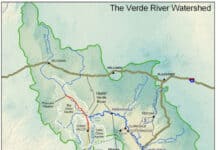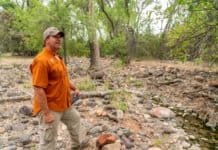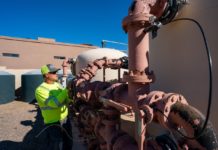Earlier this year, the Arizona Corporation Commission asked the three largest classes of water companies to give a status report on their readiness to ensure sufficient water supply in the face of drought and mandatory cuts to Colorado River allocations coming next year.
The water companies, including three that operate in the Verde Valley, presented their updates at a video conference meeting on Sept. 21.
The meeting was spurred by the federal government’s declaration of a Tier 1 water shortage on the Colorado River in August — the first time a shortage has been declared since the Colorado River Compact was ratified by seven Western states in 1944. The declaration triggers an 18% reduction in Arizona’s allocation of Colorado River water beginning in 2022.
In general, the water systems in the Verde Valley will not be directly affected by the Colorado River shortage because the Verde River basin is upriver from Colorado River water, which is delivered to Arizona via Central Arizona Project canals or through credit exchanges.
According to the Arizona Water Atlas, Camp Verde Water System and Cottonwood Water works had water entitlements from CAP that were sold to Scottsdale.
Virtually all of the local potable water comes from groundwater pumped from wells drilled into the local aquifer.
How sustainable are our local groundwater supplies?
“It is difficult to say exactly how much of the aquifer has been developed to date because the Verde River is supported by multiple aquifers and monitoring is poor,” Max Wilson, Ph.D., program manager for Friends of Verde River, wrote in an email.
Nicholas Gudovic, operations manager for Big Park Water, which supplies water to the Village of Oak Creek from several wells, said that the water level of the aquifer rises and falls seasonally as well as over multiple year cycles based on precipitation levels, making it difficult to judge the impact of pumping on the aquifer.
He estimates that the aquifer level had dropped, but not at a rate to cause concern.
“I would say we’re trending in a good direction,” Gudovic said. “We actually see a decreasing usage per customer over time …. People are switching to low flow fixtures.”
In Big Park’s update to the ACC, Gudovic wrote, “We do not see any major customer growth that would affect our water supplies.”
Gudovic said he isn’t worried about running low on water. Big Park has wells that go down 800 feet, and the water table currently sits around 400 feet. The region currently draws water from the Supai geologic formation, and he said the aquifer in the Redwall formation beneath that is “even larger.”
Wilson said small drops in the level of the aquifer can still have negative impacts, even if they don’t they don’t immediately threaten the availability of groundwater. Besides raising the cost of pumping water, he said, a lowered water table can dry up springs and reduce the base flow of streams on the surface.
“The largest threat to our water systems in the Verde Valley is that groundwater pumping is essentially unregulated,” he said. “This means that any landowner can drill a new well and pump as much as they like, even if this dries up existing wells or if it dries up our rivers and creeks. People all over rural Arizona are already seeing their wells dry up and one of the headwaters springs of the Verde, Del Rio, has nearly stopped flowing.”
Sedona’s major water supplier, Arizona Water Co., serves many populous communities across the state, including those that use Colorado River water, so its presentation to the ACC focused on those to the south and not the Verde Valley.
Terri Sue Rossi, water resources manager for AWC, told the board that the company was planning for the worst — continued drought resulting in deeper cuts to Colorado River water in 2025. She said in the short-term, until 2026, the Arizona Water Banking Authority will cover 100% of their cuts. Beyond that, the bank will only cover 20%.
Rossi said the company has implemented the following strategies to deal with the Colorado River shortage:
■ Reuse 100% of effluent and develop new effluent
■ Hire a water conservation specialist
■ Implement demand management program in 3 to 5 years
■ Secure additional renewable water supplies
She also warned that continued drought and water shortages could lead to increasing water prices, as drilling deeper wells increases pumping costs, and the loss of hydroelectric power — due to falling Colorado River levels — could increase the cost of energy.






















